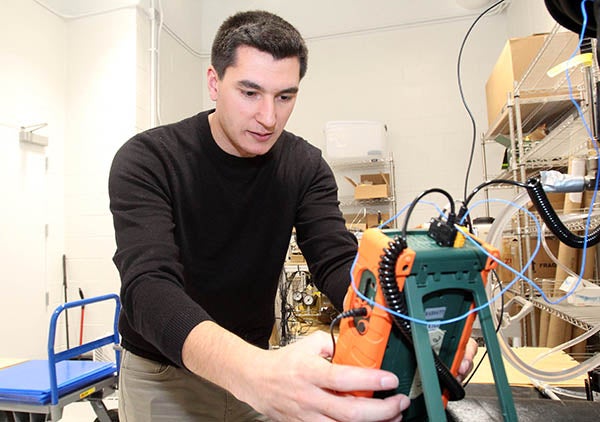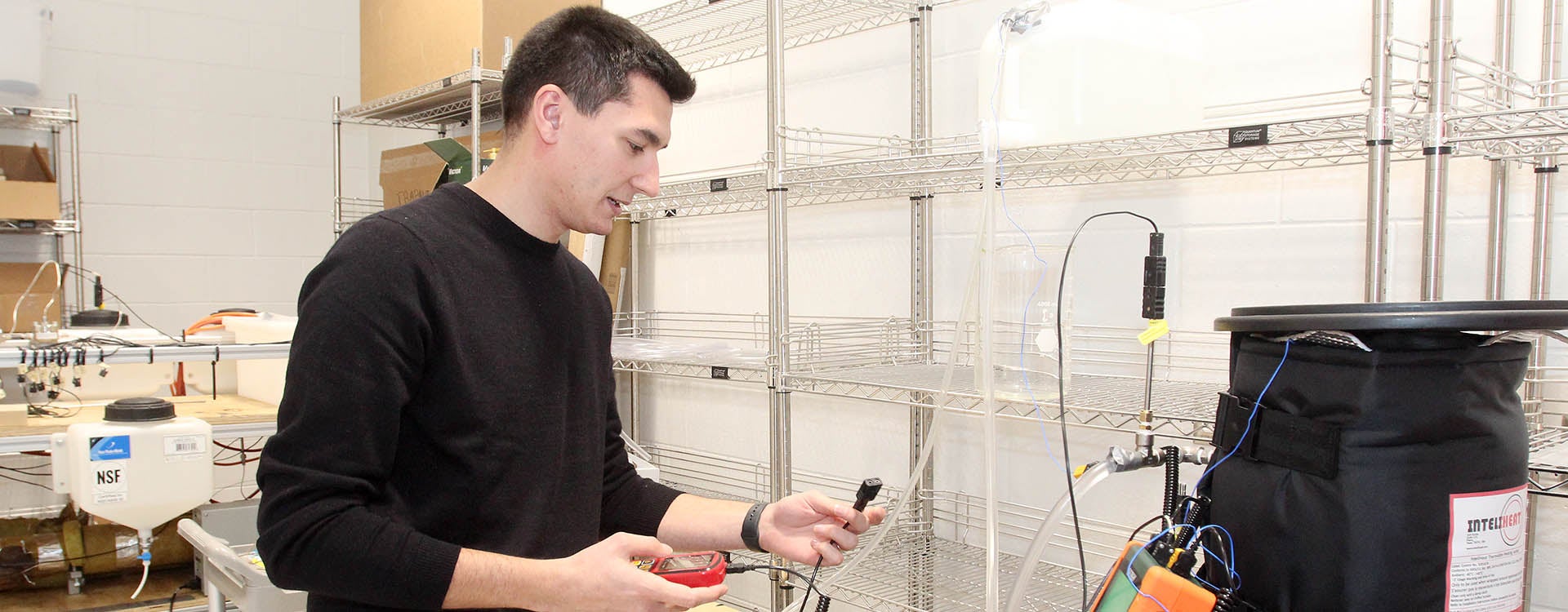Ray of Energy
Engineering grad student goes solar as part of water desalination effort
East Carolina University mechanical engineering graduate student Emre Bal puts his career goals simply.
“I want to apply my knowledge to real-life problems and save more energy, save forests and reduce greenhouse gas emissions somehow,” he said.
That passion shines in his thesis research project in which he uses solar energy to heat water as part of a no-waste, sustainable water desalination project through the College of Engineering and Technology.

Emre Bal, a graduate mechanical engineering student, checks equipment on a project in which he heats water using solar energy as part of a desalination process.
“I employ solar energy to warm the feed water in the water desalination system so that the furnace would consume less energy,” said Bal, an international student from Turkey.
He explained that the system requires a water temperature of well over the boiling point of 100 degrees Celsius. Getting to that temperature from a standard 21-degree room temperature would require a lot of energy from the furnace and adds to its greenhouse gas emissions.
In the Life Sciences and Biotechnology Building, Bal heats five gallons of water to between 50 and 60 degrees Celsius before it is put into the desalination unit. With the heated water, the desalination furnace doesn’t have to work as hard or as long to heat the water to the optimum desalination temperature, thus reducing emissions.
He has gathered solar energy data from ECU’s Outer Banks campus and is using paraffin wax as a heating element. Warming the water takes a few hours, and he is using different water temperatures to determine which one reduces emissions in the desalination furnace the most.
“The main reason for integrating the renewable energy sources into anything is basically just reducing the environmental impacts of fossil fuels and greenhouse gas emissions,” Bal said. “The Environmental Protection Agency has a greenhouse gas equivalencies calculator, and by doing this, actually bringing the 21 Celsius degree water to 58 Celsius degrees with this system, we are actually getting rid of 941,000 kilograms of carbon dioxide in the atmosphere. This is equal to carbon sequestered by 1,100 acres of U.S. forests in one year.”
Bal points out that the results are just for one device, so imagine the impact of multiple units.
“It might not be a huge difference in the short term, but in the long run, if you can integrate the renewable energy more into different systems, the change would be huge,” he said.
The goal of the no-waste desalination system is to provide drinking water to those who may be without — such as after a hurricane or other natural disaster. Renewable wave and solar energy would be used to convert seawater into clean water and solid salt crystals as part of a system that would have positive effects on the environment.
Bal credits engineering professors Drs. Tarek Abdel-Salam, Kura Duba and Jinbo Chen for guidance and support, as well as many previous graduate students who have had a hand in the overall project of no-waste, sustainable water desalination.
He said the challenges have been few, but the results have him excited about the future.
“The most fun thing about this project, like anything I do in the engineering program, just seeing the results of how you can impact and affect the environment and how you can reduce the environmental impacts,” Bal said. “Because my focus in mechanical engineering is mainly energy and my bachelor’s degree was in energy assistance engineering, seeing this is the most fun part.”
